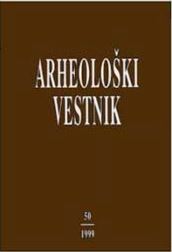Dogs from the Ig pile dwellings in the National Museum of Slovenia
Abstract
Eight skull fragments from dogs as well as the lower carnassials (M1) of 37 dogs and 4 wolves were measured in order to reconstruct the size and physical type of these ancient animals during the evaluation of prehistoric animal bone artifacts from the 19th century excavations in the Ljubljana Marshes near Ig. The complete ulnae of two additional individuals were used in estimating the withers height of dogs kept at this site. In addition to comparing the dog carnassials to those of coeval wolves, cranial dimensions and withers heights were both compared to similar measurements of Roman period urban dogs, known for their remarkable variability in size. Finally, the results from Ig were studied in light of Neolithic to Bronze Age dog remains from lacustral settlements in Switzerland and northern Italy. These calculations reconfirm that the dogs found at Ig were of the turbary dog type (C. familiaris palustris), a form evaluated within a broader context in this article.
Downloads
References
BARTOSIEWICZ, L. 1989, Animal remains from the fort. - In: D. Gabler (ed.), The Roman fort of Ács-Vaspuszta (Hungary) on the Danubian limes, BAR Brit. Ser. 531, Partii, 600-623.
BARTOSIEWICZ, L. 1994, Late Neolithic dog exploitation: chronology and function. - Acta Arch. Acad. Sc. Hung. 46, 59-71.
BARTOSIEWICZ, L. 1999, Recent developments in archaeo-zoological research in Slovenia. - Arh. vest. 50, 285-295.
BARTOSIEWICZ, L. 2000, Metric variability in Roman perioddogs in Pannonia provincia and the Barbaricum, Hungary. - In: S. J. Crockford (ed.), Dogs through time: an archaeologicalperspective, BAR Int. Ser. 889, 181-192.
BECKER, C. and F. JOHANSSON 1981, Tierknochenfunde. - Die neolithischen Ufersiedlungen von Twann11, Bern.
BOESSNECK, J., J.-P. JÉQUIER and H. R. STAMPFLI 1963, Seeberg Burgäschisee-Süd 3. Die Tierreste, Acta Bernensia2, Bern.
BÖKÖNYI, S. 1974, History of domestic mammals in Centraland Eastern Europe. - Budapest.
BUFFON, G. L. L. (1749-1788), Histoire naturelle. - Paris.
BUFON, Z. 1971, K stopetdesetletnici prirodoslovnega muzejaSlovenije v Ljubljani (Zum hundertfünfzigjährigen Jubiläumdes Naturgeschichtlichen Museums in Ljubljana). - Argo10, 164-200.
DENNIS-BRYAN, K. and J. CLUTTON-BROCK 1988, Dogsof the last hundred years at the British Museum (NaturalHistory). - London.
DESCHMANN, K. 1875, Die Pfahlbaufunde aus dem LaibacherMoore. - Verhandlungen der k. u. k. geologischen Reichsanhalt15, 275-284, Wien.
DESCHMANN, K. 1876, Bericht über die Pfahlbauten-aufdeckungen im Laibacher Moore. - Sitzber. Phil.-hist. Cl. k. k. Akad. Wiss. 84, 471-484, Wien.
DRIESCH, A. von den 1976, A guide to the measurement ofanimal bones from archaeological sites. - Peabody MuseumBulletin 1, Cambridge, Mass.
DROBNE, K. 1963, Subfosilni živalski ostanki iz mostiščarskedobe na Ljubljanskem Barju I-II. - Dissertation, Inštitutza geologijo Univerze v Ljubljani, Ljubljana.
DROBNE, K. 1975, Fauna količarskih naselbin na Ljubljanskembarju. - Arh. vest. 24, 217-224.
DROBNE, K. 1983, Bronzezeitliche Wild- und Haustiere amLjubljaner Moor (Jugoslawien). - In: M. Kubasiewicz (ed.) Archaeozoology I. Proceedings of the 3rd Conference of theInternational Council for Archaeozoology 1978, 577-579, Szczecin.
EIBL, F. 1974, Die Tierknochenfunde aus der neolitischen StationFeldmeilen-Vorderfeld am Zürichsee I. Die Nichtwiederkäuer. - Diss. Institut für Paläoanatomie, Domestikationsforschungund Geschichte der Tiermedizin der Universität München, München.
GREIF, T. 1997, Prazgodovinska kolišča na Ljubljanskembarju. - Arheo 18, 1-95.
HESCHELER, K. and J. RÜEGER 1942, Die Reste der Haustiereaus den neolitischen Pfahlbaudörfern Egolzwil 2 (Wauwilersee, Kt. Luzern) und Seematte-Gelfingen (Baldeggersee, Kt. Luzern). - Vierteljahrschrift der Naturforschenden GesellschaftZürich 87, 383-486.
HILZHEIMER, M. 1932, Römische Hundeschädel aus Mainz, ein fränkischer Hundeschädel und ein Hundeschädel des 15. oder 16. Jahrhunderts ebendaher. - Biol. gen. 8, 91-126.
HÜSTER-PLOGMANN, H. and J. SCHIBLER 1997, Archäozoologie. - In: J. Schibler et al. (eds), Ökonomieund Ökologie neolitischer und bronzezeitlicher Ufersiedlungenam Zürichsee, Monographien des Kantonsarchäologie Zürich20, 40-121.
KOUDELKA, F. 1885, Das Verhältnis der Ossa longa zurSkeletthöhe bei Säugertieren. - Verh. d. Naturforsch. Verein24, Brünn.
MENZEL, K. M. 1960, Pariahunde. - Die Neue Brehm Bücherei, Wittenberg Lutherstadt.
PARZINGER, H. 1984, Die Stellung der Uferrandsiedlungenbei Ljubljana im äneolitischen und frühbronzezeitlichenKultursystem der mittleren Donauländer. - Arh. vest. 35, 13.
PUCHER, E. and K. ENGL 1997, Studien zur Pfahlbauforschungin Österreich. Materialen I - Die Pfahlbaustationen desMondsees. Tierknochenfunde. - Mitt. Prähist. Komm. 33.
RIEDEL, A. 1976, La fauna del villaggio preistorico di Barchedi Solferino. - Atti del Museo Civico di Storia Naturale -Trieste 29/4, 215-318.
RIEDEL, A. 1989, Die Fauna einer bronzezeitlichen Siedlungbei Peschiera am Gardasee. - Rivista di Archeologia 6, 23-27.
RÜTIMEYER, L. 1862, Die Fauna der Pfahlbauten der Schweiz. - Neue Denkschrift der all. Gesellschaft d. ges. Naturwissnschaften 19.
SÁRKÁNY, P. and I. ÓCSAG 1977, Ungarische Hunderassen. - Budapest.
SCHIBLER, J. 1987a, Osteoarchäologische Untersuchungender neolitischen Knochenkomplexe. - In: P. J. Suter (ed.), Zürich “Kleiner Hafner”, 167-179, Zürich.
SCHIBLER, J. 1987b, Die Stichprobenanalyse desTierknochenmaterials. - In: E. Gross et al. (eds), Zürich “Mozartstrasse. Neolitische und bronzezeitliche Ufersiedlungen1, Berichte der Zürcher Denkmalpf lege, Monographien4, 190-197.
STAMPFLI, H. R. 1976, Osteo-archaeologische Untersuchungdes Tierknochenmaterials der spätneolitischen UfersiedlungAuvernier La Saunerie nach den Grabungen 1964 und 1965. - Solothurn.
VELUŠČEK, A. 1999, Neolithic and Eneolithic Investigationsin Slovenia. - Arh. vest. 50, 59-72.
Downloads
Published
How to Cite
Issue
Section
License

This work is licensed under a Creative Commons Attribution-NonCommercial-NoDerivatives 4.0 International License.
Authors guarantee that the work is their own original creation and does not infringe any statutory or common-law copyright or any proprietary right of any third party. In case of claims by third parties, authors commit their self to defend the interests of the publisher, and shall cover any potential costs.
More in: Submission chapter





